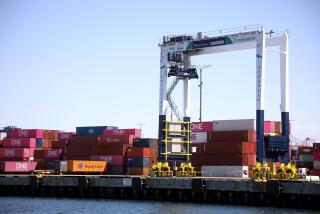Climbing Two Energy Mountains With Some Magic : Cleaner new technology tames the older, dirty technology
Because nature has such a big hand in Southern California smog, the region’s best hope for clean air is energy from sources that leave virtually no trace.
Until recently, the prospect that clean energy would be available any time soon at prices low enough to make a difference seemed more in the realm of magic than science. Now, in the space of a week, utility companies say that not just one source but two are on the way.
A week like that is spectacular news for the region with the dirtiest air in the United States, on more than one count. It is directly good news because both kinds of clean energy should have carved out a sizeable beachhead in Southern California by the end of the decade. It is also good news because there has been much skepticism--and not without cause--about the air quality district’s position that new technologies would somehow turn up to help produce cleaner air. It is always better to count on science than magic, but Southern California is not in any position to be choosy.
MAGIC TWICE: The first surprise announcement came in late March from the Southern California Gas Co., which is building a much larger version of the kind of fuel cells that have provided clean power for U.S. space shuttles for a decade. The plant, which will use natural gas, will produce both electricity for lighting and hot water for heating the new Diamond Bar headquarters of the Southern California Air Quality Management District starting early next year.
The second was from Southern California Edison Co., which says it is in the final stage of developing a device to convert sunlight to electricity that will cut the cost of such photovoltaic systems by 80% or more. Edison is starting to test its laboratory breakthrough on a larger scale and should be ready by the mid-1990s to market solar cells that would supply one-third of the power used by an average Southern California home.
The solar device, which was developed jointly by Edison and Texas Instruments Inc., costs $1.50 to $2 per watt to produce electricity, a price that is nicely below the current cost of nuclear power. The fuel cell will cut the district’s electric bill by 10% to 15%.
Natural gas is the cleanest-burning fossil fuel, but fuel cells do not burn anything, so nothing will escape that contributes to smog and carbon dioxide discharges will be less than 5% of what burning hydrocarbons generate.
Instead fuel cells, like car batteries, use an electrochemical process. In the air district model, natural gas will be cracked at high temperatures into hydrogen and carbon atoms, electrons will be stripped from the hydrogen and turned into direct-current electricity, and finally hydrogen ions will combine with oxygen to make steam and, in turn, hot water.
Southern California Gas already is preparing to put fuel cells in nine other big buildings in the next two years and hopes to have a smaller version ready for homes by the mid-1990s.
Fuel cells have been technically possible to build since the 1960s. The breakthrough in the gas company’s venture for the air quality district was primarily economic, a case in which the price came down after years of research to open up the market.
The solar cell is both a technical and economic breakthrough that, ironically, started out with Texas Instruments trying to to operate a fuel cell with heat from the sun.
The experiment never got beyond the laboratory stage, but Nick Patapoff, a senior research engineer, had been following the experiment and persuaded Edison to talk with TI about the particular type of silicon, the raw material of solar cells, that the Texas company was using.
MAGIC AGAIN: What intrigued him, he says, was the cost. TI used metallurgical silicon, a material normally used as an alloy in aluminum and other metals. It costs $1 a pound. Silicon for most solar cells costs up to $75 a pound because it must be computer-chip quality, pure enough to let electrons flow smoothly.
Edison and TI began experimenting with the cruder silicon in 1984. At one point, they melted it into tiny round pellets and embedded them in a mesh formed from heavy aluminum that could be used to form roof panels. In that combination, the cruder silicon carried electrons as smoothly as the high-priced brand.
“The magic was turning them into spheres,” Patapoff says.
Edison says that its photovoltaic process will be at its best between 2 p.m. and 7 p.m. during the summer when conventional power plants are straining to meet demand with air conditioners going at full tilt.
The next step is a two-year test to confirm that what was built in the laboratory can move on a production line. But Californians need not wait until then to contemplate the beauty of one technology’s rescuing them from another technology’s dirty air.
More to Read
Inside the business of entertainment
The Wide Shot brings you news, analysis and insights on everything from streaming wars to production — and what it all means for the future.
You may occasionally receive promotional content from the Los Angeles Times.










